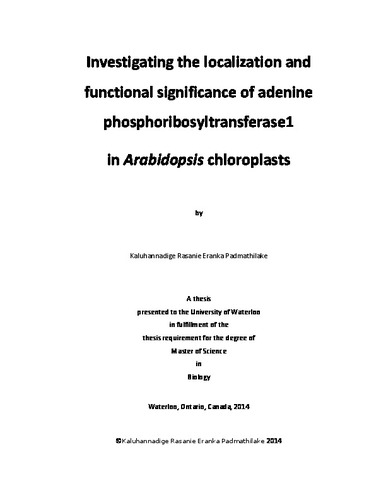| dc.contributor.author | Padmathilake, Kaluhannadige Rasanie Eranka | |
| dc.date.accessioned | 2014-09-02 13:02:54 (GMT) | |
| dc.date.available | 2014-09-02 13:02:54 (GMT) | |
| dc.date.issued | 2014-09-02 | |
| dc.date.submitted | 2014 | |
| dc.identifier.uri | http://hdl.handle.net/10012/8747 | |
| dc.description.abstract | Adenine phosphoribosyltransferase (APT) is a housekeeping enzyme that catalyses the principal route of adenine recycling in plants. Of the five APT genes encoded in the Arabidopsis genome, APT1 is the most highly expressed. The APT1 locus encodes two polypeptides: APT1.1 and APT1.2 with APT1.1 being the slightly larger of the two due to having extra exon at its 5’ end. This exon contains a predicted chloroplast targeting sequence. The APT1 mutants apt1-3 and oxt1, have low levels of APT activity, in the range of 1-6% that of the wild type, and increased adenine content (i.e. oxt1 chloroplasts have 12-fold more adenine than WT plastids). The first aim of this study was develop a system to test whether the increased adenine in plastids of apt1 mutants is essential for their oxidative stress tolerance. A second objective was to determine the localization of APT1.1 in chloroplasts.
The adenine deaminase (ADE) activity encoded by the AAH1 gene of Saccharomyces cerevisiae was transferred into apt1 mutants with the objective of reducing the adenine content at chloroplasts. A targeting sequence was fused with the coding sequence of AAH1 to direct ADE activity into the plastid. The construct was first introduced into WT plants under control of the constitutive UBQ10 promoter, and the transgene subsequently transferred to apt1-3 and oxt1 mutants by genetic crossing. Additional constructs containing the coding sequence for green fluorescent protein (GFP) fused to either the transit sequence or the C-terminus of the AAH1 sequence were created to verify the import of ADE into plastids. Transformants were evaluated for the presence of the AAH1 transgene, transcript, protein and enzyme activity. The expression of the ADE-GFP fusion protein was analyzed by confocal microscopy and immunoblotting. ADE enzyme activity was assayed using a coupled spectrophotometric method. Finally, chloroplast subfractionation followed by immunoblotting was used to investigate the chloroplast localization of APT1 in WT plants.
While immunoblotting and polymerase chain reaction assays of cDNA prepared from the transgenic lines provided evidence that they expressed the full-length ADE transgene, ADE enzyme activity in leaf extracts was undetectable. Confocal microscopy showed that the ADE-GFP was imported successfully into plastids. Subfractionation of WT chloroplasts indicated that APT1.1 is localized in the membrane fraction. However it is yet to be confirmed whether APT1 is attached to the outer envelope membrane or one of the internal membranes (inner envelope membrane or thylakoid membrane). | en |
| dc.language.iso | en | en |
| dc.publisher | University of Waterloo | en |
| dc.subject | Adenine phosphoribosyltransferase | en |
| dc.subject | APT | en |
| dc.subject | Arabidopsis thaliana | en |
| dc.subject | chloroplasts | en |
| dc.title | Investigating the localization and functional significance of adenine phosphoribosyltransferase1 in Arabidopsis chloroplasts | en |
| dc.type | Master Thesis | en |
| dc.pending | false | |
| dc.subject.program | Biology | en |
| uws-etd.degree.department | Biology | en |
| uws-etd.degree | Master of Science | en |
| uws.typeOfResource | Text | en |
| uws.peerReviewStatus | Unreviewed | en |
| uws.scholarLevel | Graduate | en |

